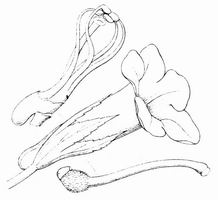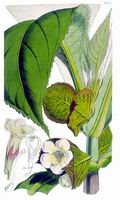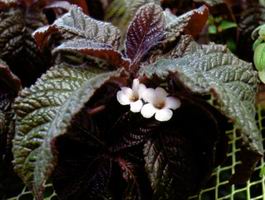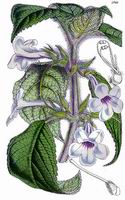
Original illustration (iconotype)
Full name and orig. publication: Nautilocalyx [Linden ex] Hanst., Linnaea 26: 207 (April 1854, "1853").
Etymology: Composed of the Latin Nautilus, a sailor or a marine mollusc with peculiar shell, and the Latin calyx = calyx. It is not clear what the name alludes to.
Synonyms: Physodeira Hanst. (1854), Skiophila Hanst. (1854), Nauticalyx Hort. ex Loud. (1855), Episcia Mart. subgen. Physodeira (Hanst.) (1865), Episcia sect. Nautilocalyx (Hanst.) Benth. (1876), Episcia sect. Skiophila (Hanst.) Benth. (1876), Episcia sect. Physodeira (Hanst.) Benth. (1876), Episcia sect. Episcia subsect. Centrosolenia (Benth.) Leeuwenb., p. p. (1958), Episcia sect. Episcia subsect. Physodeira (Hanst.) Leeuwenb. (1958), Episcia sect. Tarachanthus Leeuwenb. (1958), Episcia sect. Trichosperma Leeuwenb. (1958).
Infrafamilial position: Gesnerioid Gesneriaceae (Gesnerioideae) - Episcieae.
Description: Terrestrial perennial herbs. Stem erect, ascending or decumbent, ± succulent. Leaves opposite, in distant pairs or (rarely) forming a loose rosette. Inflorescences axillary, fascicled cymes, or flowers solitary, bracteoles sometimes leafy. Sepals unequal, the upper one forced back around the corolla spur, green or colored. Corolla white to yellow, usually with purple spots or lines, oblique in the calyx, tube laterally broadened, with a short basal sac or spur, limb with nearly equal lobes, entire, their margins toothed or fimbriate. Stamens 4, included; filaments basally connate and adnate to base of corolla tube; anthers cohering in two pairs by their apices, dehiscing by a longitudinal slit. Nectary a single dorsal or of two glands. Ovary superior; stigma bilobed. Fruit a bivalved capsule.
Chromosome number: 2n = 18.
Species number: Over 70.
Species names (incl. publication and synonyms): See Skog, L.E. & J.K. Boggan. 2005: World checklist of Gesneriaceae: http://persoon.si.edu/Gesneriaceae/Checklist.
Type species: Nautilocalyx hastatus [Linden ex] Hanst., nom. illeg. (Centrosolenia bractescens Hook.) = N. bracteatus (Planch.) Sprague
Distribution: Throughout tropical America except SE Brazil.
Ecology: Terrestrial herb, growing in shady, wet places and rocks in forests.
Notes: The white or yellow episcioid corolla suggests pollination by euglossine bees (gynandro-euglossophily).
Selected references: Sprague, Kew Bull. 85-90 (1912), rev.; Wiehler, Selbyana 5: 29-45 (1978), emend. & rev.; Skog, Ann. Missouri Bot. Gard. 65: 954-958 (1979), reg. rev. (Panama); Chautems in Ribeiro et al., Fl. Res. Ducke (1999), reg. rev.; Feuillet & Steyermark, Fl. Venezuel. Guayana 5 (1999), reg. rev.
Bibliography: See Skog, L.E. & J.K. Boggan. 2005. Bibliography of the Gesneriaceae. 2nd edition: http://persoon.si.edu/Gesneriaceae/Bibliography.
Illustrations:
 |
Nautilocalyx bracteatus (Planch.) Sprague
[= N. hastatus Linden ex Hanst., nom. illeg., type = Centrosolenia
bractescens Hook.]
Original illustration (iconotype) |
 |
Nautilocalyx bracteatus (Planch.) Sprague
Bot. Mag. t. 4675 (1852), as Centrosolenia bractescens |
 |
Nautilocalyx aeneus (Linden & Andre) Wiehler
Cult. Marie Selby BG, phot. A. Weber (1982) |
 |
Nautilocalyx villosus (Kunth & Bouche)
Sprague
Bot. Mag. t. 4866 (1855), as Drymonia villosa |
last modified: 2007-01-05